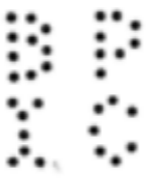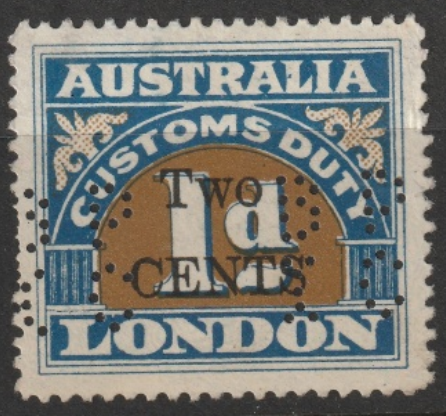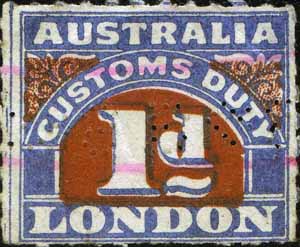|
Private Revenue Perfins of the Commonwealth of Australia An Elsmore Coath production The authors would welcome your comments additions or input into this work B -------------------------------------------------------- B&F.a
User: Unknown Revenue Use: 1923 issue ¼d Rarity Scale: 1923 issue ¼d R4
Background: Unknown Device: Most likely a single die device, as the examples the authors have seen show clear, single, central strikes on the large format Customs Duty stamps. A Multi Die device designed for contemporary GB postage stamps would feature dies with closer spacing and would therefore show strikes of at least 2 dies on these larger format Customs Duty stamps. The authors have been unable to find a complete match to this pattern in “The New Illustrated Catalogue of GB Perfins”; in fact there is some confusion in this catalogue regarding the B&F pattern found on Customs Duty stamps. The GB Catalogue reports that B&F 2630.04 is found on Customs Duty stamps. This pattern is confirmed to Booth and Fox, bedding manufacturers. However this pattern, 2630.04, is different to B&F.a as it does not have the same flat-bottomed ampersand. Furthermore 2630.04 is stated to have been in use from 1879-1884. This usage period is too early for Customs Duty stamps which were not issued until 1907 and further B&F.a is only reported on issues of the 1923 Series. The authors conclude that this report of 2630.04 use on Customs Duty stamps is an miss report, most likely caused by confusion between the almost 20 different B&F’s in the GB Catalogue. The closest match that the authors can find to B&F.a in the GB Catalogue is B&F 2630.01a. Its stated usage period of 1930-1945 is also more appropriate to the example we have seen on Customs Duty stamps. The pattern B&F 2630.01a is only a fair match but there is a note in the GB Catalogue for this pattern that says, "minor variations reported" and this could explain why the authors cannot find a better match. Another possible candidate from the GB Catalogue is B&F 2630.06. This pattern shares many of the characteristics of B&F 2630.01a including the rounded base of the B and the flat-bottomed ampersand but the scale of B&F 2630.06 is much smaller than B&F.a and indeed B&F 2630.01a. On the balance of probabilities B&F.a is most likely the pattern described in the GB Catalogue as B&F 2630.01a. Unfortunately the B&F 2630.01a pattern has no known user but they could be Booth and Fox or possibly the coppersmiths Benham and Froud. Related Patterns: Nil -------------------------------------------------------- BP/IC.a
User: Business Publishers
International Corporation Publishers Address: 330
West 42nd St, New York, USA Revenue Use: 1924 issue 1d Rarity Scale: 1924 issue 1d R5
Background: "Business Publishers International Corporation" were a division of McGraw Hill and they had previously been located in the "Hill Building" at 469-473 10th Avenue, New York. James Herbert McGraw (1860-1948) and John Alexander Hill (1858-1916) were pioneers in the publication of specialized journals for the electrical and engineering fields. Hill
had worked as a Railroad Engineer before moving
to New York in 1888 to work at the
"American Machinist Publishing Company". He was
soon promoted to Editor of "Locomotive
Engineer", and he acquired the publication in
1891, later forming the "Hill Publishing
Company" in 1901. "Hill
Publishing" was responsible for five major
engineering journals as follows, "American
Machinist" 'Power" "Engineering News",
"Engineering and Mining Journal", and "Coal Age" In 1914
Hill built the 12 story "Hill Building" at
469-473, Tenth Avenue, New York. McGraw,
from Panama, New York, worked as a printer and
later as a school teacher before coming to New
York City in 1885 to join the "American Railway
Publishing Company". He later took over the
"Street Railway Journal" and built up "McGraw
Publishing Company", which by 1917 it was
responsible for major electrical and engineering
journals, as follows, "Electrical World"
"Electric Railway Journal" "Electrical
Merchandising "Engineering Record"
"Metallurgical and Chemical Engineering" and
"The Contractor". McGraw's company was located
at 239 West, 39th Street, from about 1910. McGraw and Hill first joined forces in 1909. Each had branched out into the publication of engineering books, and in that year, they merged their side-line operations into the "McGraw-Hill Book Company". Sometimes referred to as simply "The Book Company". It is said that a "flip of a coin" determined that Hill would be its president and that McGraw's name would be first in the Company name. Following Hill's death in 1916, the Companies, which had been rivals, merged to form the "McGraw-Hill Publishing Company" in 1917, with James McGraw as president. McGraw-Hill
expanded over the next twelve ears. The new
company moved into the Hill Building at Tenth
Avenue. In 1926 McGraw-Hill formed a "Catalogue
and Directory Company, Inc", and this was linked
to the this "Business Publishers International
Corporation". By 1929 McGraw-Hill was publishing
over thirty journals, and its branches were
spread all over New York City. It was at this
point that they decided to build a large and
dedicated building at 330 West 42nd Street in
New York. The building was completed by 1931. The
company continued to expand and today they are
one of the 3 main Publishing Houses in the
World. Reference: http://s-media.nyc.gov/agencies/lpc/lp/1050.pdf Related Patterns: Nil -------------------------------------------------------- B&S.a
User: Barr & Sons Seed men Address: 11-13 Kings St, Covent Garden, London, UK Revenue Use: 1911 issue 1d Rarity Scale: 1911 issue 1d R5
Background: Barr and Sons were seed sellers including bulbs and tuber, who are known to have produced and distributed Seed Catalogues over the period 1888-1930, however most of their catalogues are reported in the period 1895-1915. Device: Multi Die device of at least 2 dies in a horizontal array. The authors have sighted an example that shows 2 incomplete strikes on the wider Customs Duty stamp. The spacing between the dies looks suited to the smaller format contemporary GB definitive's. The dies are essentially identical. This pattern is listed in “The New Illustrated Catalogue of GB Perfins” in the B section as 6430.06 and the device is stated to have been in use from 1895 until 1939. Related Patterns: Nil --------------------------------------------------------
© copyright 2011 |





